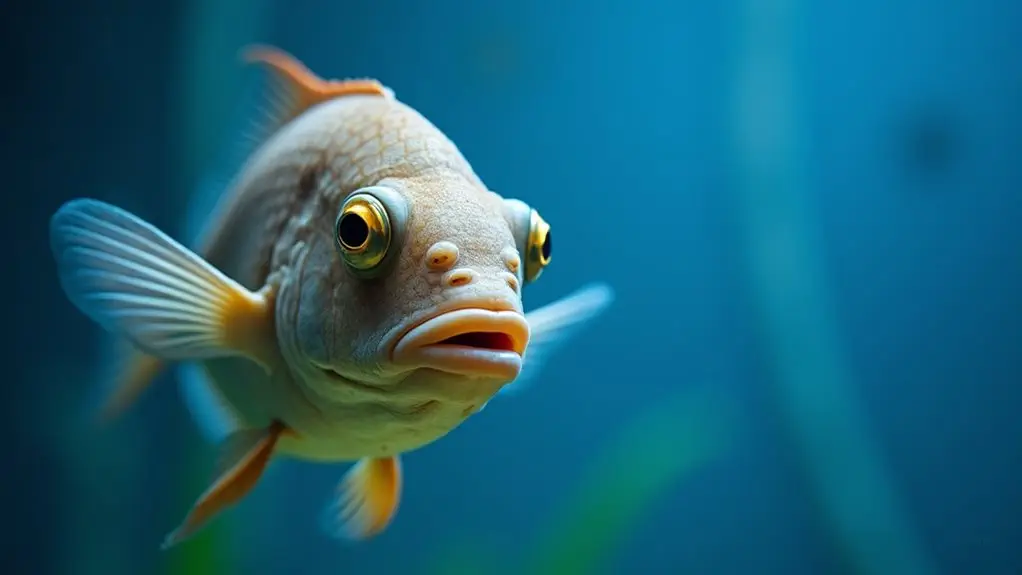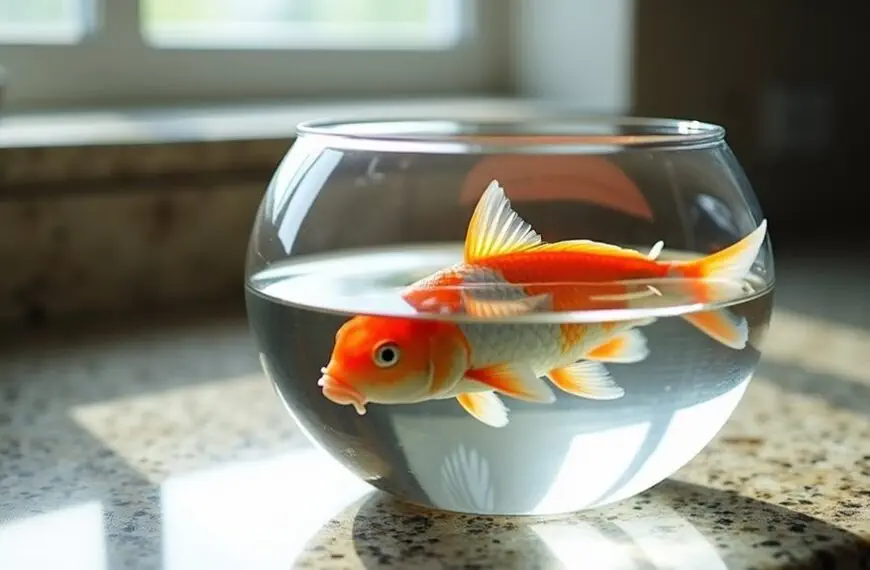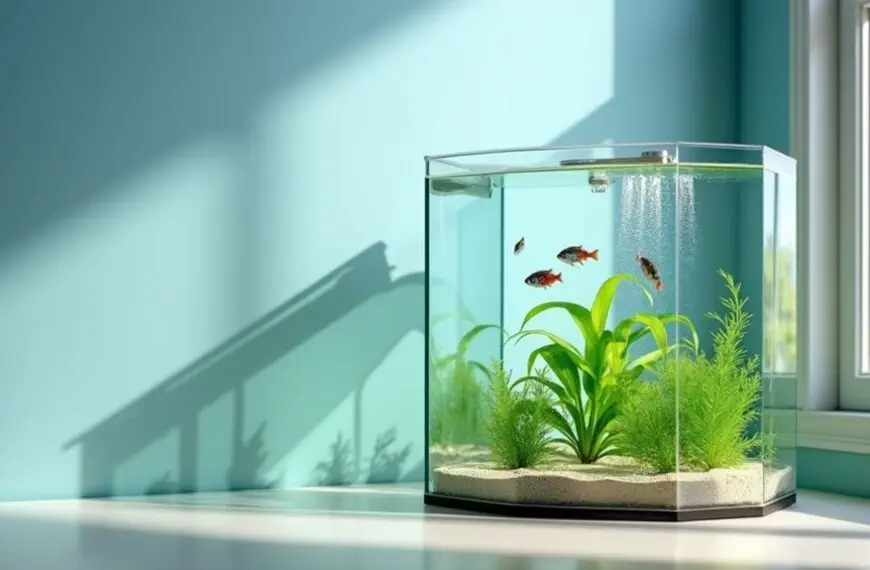You'll know your fish is stressed by watching for key physical and behavioral changes. Look for fading colors, clamped fins (held close to the body), rapid breathing, or excessive hiding. If your fish starts swimming erratically, rubbing against objects, or refusing food, that's a red flag. Changes in water quality, like cloudiness or unusual odors, often trigger stress in fish. Pay attention to species-specific reactions too – for example, discus fish darken when stressed, while oscars become pale. Understanding these warning signs is just the first step in keeping your aquatic friends happy and healthy.
Contents
Physical Signs of Fish Stress
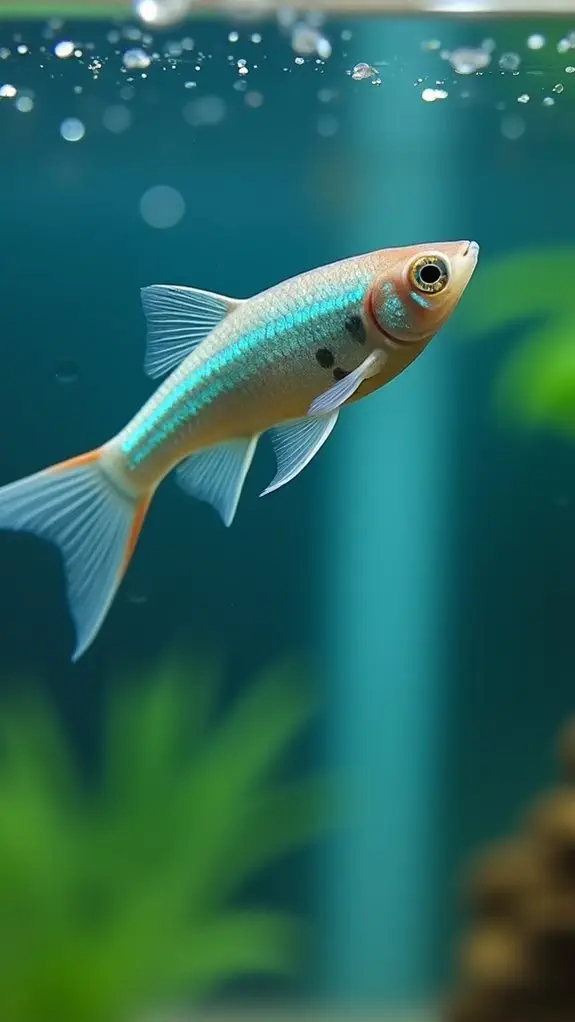
A fish's physical appearance serves as a clear window into its well-being. When your aquatic friend is under stress, you'll notice several telltale signs that shouldn't be ignored. One of the most obvious indicators is fading colors – your once vibrant swimmer might start looking more like an old photograph that's lost its luster. The scientific assessment of these signs has evolved significantly, using cellular-level indicators to confirm visible stress markers. Maintaining optimal water parameters is essential for preventing stress and supporting fish health.
If you spot your fish's fins tucked close to its body (what we call clamped fins), that's another red flag you shouldn't miss.
Watch out for rapid breathing or if your fish seems to be gasping at the surface – it's like they're running a marathon they didn't sign up for. You might also notice concerning changes like weight loss, fin rot, or red streaking in their fins. Early detection and monitoring of these symptoms can help prevent stress-related diseases in your fish.
Those pesky white spots or visible sores can pop up too, and if you see your fish scraping against rocks like they're trying to scratch an itch, something's definitely up. A loss of appetite is particularly concerning – when a fish turns down breakfast, it's usually a sure sign they're feeling under the weather.
These physical signs are your fish's way of waving a tiny distress flag.
Common Behavioral Changes
Spotting behavioral changes in your fish requires careful observation of their daily routines. You'll want to pay attention to how they're swimming, eating, and interacting with their tankmates, as these behaviors can tell you a lot about their stress levels.
Watch for changes in their swimming patterns – if your fish is darting around erratically or swimming in circles, something's likely bothering them. They might also start rubbing against objects in the tank, which is their way of saying "I'm not feeling great!" Poor water quality often leads to fish gasping at the water surface. It's important to maintain suitable water parameters to prevent stress-related behaviors. To help avoid heightened levels of stress, ensure that you perform regular maintenance such as monthly water changes.
Changes in feeding routines are another red flag. If your usually hungry fish turns its nose up at dinner time or starts overeating, it's time to investigate what's wrong.
Keep an eye on social dynamics, too. Your once-friendly fish might suddenly become aggressive, chasing others around the tank like they're training for an underwater marathon.
Or they might do the opposite and become shy, hiding behind plants and decorations more than usual. These changes in personality and social behavior are clear signals that your finned friend is feeling stressed and needs your help.
Water Quality and Environmental Issues

Your fish's health directly depends on the quality of their water, and you'll want to watch for warning signs like cloudy water, unusual odors, or a filmy surface.
If you're seeing these issues, there's a good chance your tank's chemical balance is off, which means you'll need to check your water parameters right away. Maintaining stable ecosystems is vital to reduce stress and illness in aquatic populations.
You can prevent many stress-related problems by maintaining proper pH levels, ammonia readings, and temperature, just like you'd keep your own living space clean and comfortable.
For optimal fish health, maintain water temperature between 15-25°C as this range supports normal physiological functions.
Heavy breathing at the water surface often indicates poor oxygen levels or water quality issues.
Poor Quality Warning Signs
Keeping an eye out for poor water quality warning signs helps prevent serious health issues in your aquarium fish. Through regular water testing, you'll be able to spot stress triggers before they become major problems.
If you notice your fish gasping at the surface or their gills moving rapidly, it's a clear sign that oxygen levels are too low – think of it as your fish trying to catch their breath! Frequent surface visits and unusual swimming patterns often indicate distress in fish. Maintaining proper nitrate levels is essential for fish health and helps avoid such distress signals.
You'll want to watch out for signs of toxic buildup too. When ammonia and nitrite levels rise, your fish will show obvious distress signals.
Don't forget about temperature – your finned friends are quite particular about their comfort zone, and sudden changes can really throw them off balance. Just like us, they don't appreciate unexpected hot or cold spells! Testing water temperature helps ensure it remains within an ideal range for your species.
Environmental stressors can also make your fish feel uneasy. If your tank is overcrowded or lacking cozy hiding spots, you'll notice your fish acting nervous or agitated.
Keep an eye on lighting levels and noise around the tank – fish appreciate their peace and quiet, and proper lighting schedules help them feel secure in their underwater home.
Tank Chemical Balance Issues
Tank pH fluctuations are often the first sign of trouble, especially when there's excess organic material or overcrowding in your aquarium. Regular testing helps reveal these changes before they become serious since poor water conditions typically develop gradually over time. New tanks are particularly vulnerable as it takes 4-6 weeks for beneficial bacteria to establish proper filtration, which is crucial for maintaining a stable environment.
You'll want to keep a close eye on ammonia levels, as even small amounts can be deadly to your aquatic friends. Think of ammonia as the fish equivalent of breathing toxic fumes – not something you'd want your finned pals dealing with! Regular water testing is your best friend here, and you shouldn't hesitate to perform water changes when needed, especially after noticing any elevated toxin levels in the water. If your tap water contains chlorine or chloramine, don't forget to use a water conditioner – it's like giving your fish a safety blanket.
Watch out for mineral imbalances too, particularly if you're using well water. Those rusty colors or stubborn algae growth might be telling you there's too much iron or silicate in your water.
Disease and Health Indicators
Fish diseases can manifest through various physical and behavioral indicators that every aquarium owner should recognize. When it comes to disease prevention, you'll want to watch for sudden changes in your fish's appearance and behavior. If your normally social swimmer starts hiding or loses interest in food, that's your cue to investigate further. Regular testing of water quality can significantly aid in identifying stressors that might lead to health issues in fish.
Regular health monitoring can help you spot issues before they become serious problems. You'll notice physical signs like white spots on fins (possibly ich), bulging eyes, or excessive mucus on the body. Kidney failure often leads to dropsy in freshwater fish.
Keep an eye out for fish gasping at the surface or swimming erratically – these aren't just your fish showing off their underwater dance moves! If you spot open wounds or ulcers, they're often linked to poor water quality and need immediate attention.
Don't forget to monitor those gills – they should be nice and pink, not discolored. And if your fish starts doing the upside-down shuffle or looks bloated, it's definitely time for a closer look.
Species-Specific Stress Symptoms
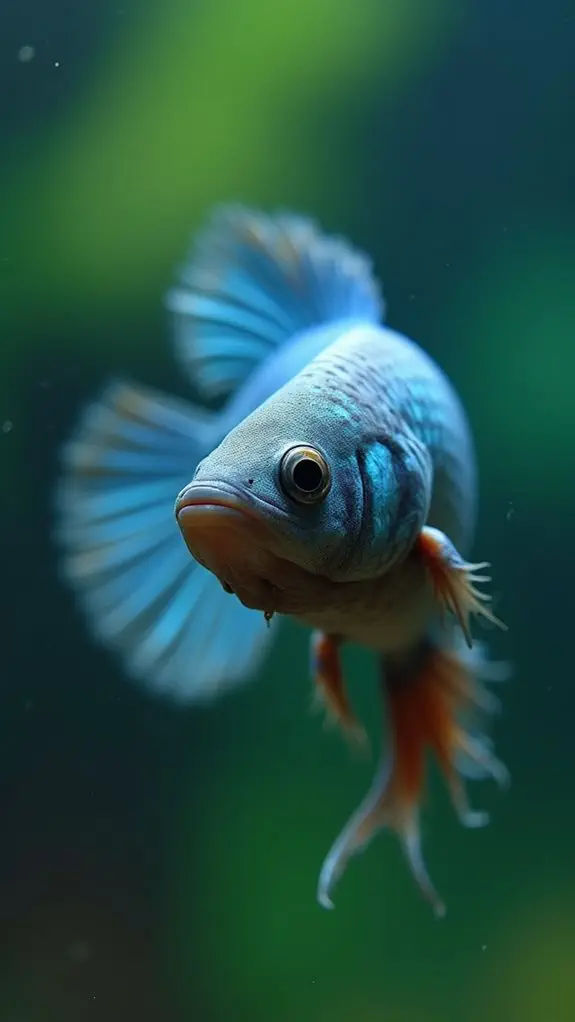
Different aquatic species display unique stress signals that you'll need to recognize for proper care. For instance, when discus stress occurs, these fish dramatically darken in color, while oscars do just the opposite, becoming noticeably pale when they're feeling under the weather.
If you've got African cichlids, they'll show their discomfort in soft or acidic water by just looking "off" – it's like they're having a bad hair day, but for fish!
Your betta or cichlids might turn into little aquatic bullies when they're stressed, picking fights with their tankmates. Goldfish, those seemingly hardy pets, can get stressed when their water's too warm, though they're a bit more subtle about showing it.
Keep an eye out for common signs across species, like clamped fins (when they're holding their fins close like they're giving themselves a hug), rapid gill movements, or faded colors.
You might also notice your fish hiding more than usual or swimming erratically – think of it as their version of pacing back and forth when anxious. Ensuring ideal water conditions is critical to reducing stress and promoting overall health in your aquarium.
Treatment and Prevention Methods
Once you've spotted the warning signs of stress in your aquatic pets, taking swift action becomes your top priority. Your first step should be testing the water parameters, including ammonia, nitrites, and pH levels, as poor water quality is often the main culprit behind fish stress.
For immediate stress relief, start with your aquarium setup. You'll want to make sure your tank isn't overcrowded and has plenty of hiding spots using plants and decorations – think of it as creating a cozy underwater retreat for your finned friends!
Regular maintenance is vital, so keep up with partial water changes and filter cleaning to maintain ideal conditions. Additionally, aim for weekly water changes to prevent the buildup of harmful chemicals and stabilize the environment.
Don't forget to check your equipment regularly – a malfunctioning heater or filter can quickly turn your peaceful aquarium into a stressful environment.
If you're introducing new fish, always quarantine them first and make additions gradually to prevent territorial disputes. You can also use stress-coating products to help soothe your fish during challenging times.
Remember to maintain consistent feeding and lighting schedules – fish are creatures of habit, and they'll appreciate your predictable routine just as much as you appreciate your morning coffee!
Frequently Asked Questions
Can Fish Experience Emotional Stress Like Humans Do?
Yes, you'll find that fish can experience emotional stress much like humans. Their behavior changes and stress indicators, such as reduced appetite and erratic swimming, demonstrate their capacity to feel emotional distress through similar brain structures.
How Long Does It Take for a Stressed Fish to Recover?
Your fish's recovery time depends on whether it's acute or chronic stress. For acute stress, you'll see improvement within hours. With chronic stress factors, you'll need to allow several days to weeks for recovery.
Do Fish Get Stressed During Thunderstorms or Loud Noises?
Yes, your fish can experience stress during thunderstorms and loud noises. They're sensitive to vibrations and sound pressure changes. Thunderstorm effects and noise sensitivity can cause them to display anxious behavior and altered swimming patterns.
Will Stressed Fish Pass Their Stress to Other Tank Mates?
Yes, your fish's stress can spread through tank dynamics and social hierarchy. When one fish shows stress symptoms, others often pick up on the behavioral changes, leading to a chain reaction throughout the aquarium community.
Does Adding New Decorations to an Aquarium Stress Fish?
Yes, your aquarium setup changes can stress fish. When you add new decorations, you'll notice changes in fish behavior. It's best to introduce items gradually and monitor how your fish respond.
Final Thoughts
When you're caring for fish, it's essential to monitor their well-being and act quickly if you spot signs of stress. By keeping tabs on water quality, watching for behavioral changes, and maintaining a healthy environment, you'll help your finned friends thrive. Remember, every fish species has unique needs, so you'll want to learn about your specific fish's requirements. With proper care and attention, you can guarantee your aquatic pets stay happy and healthy.

